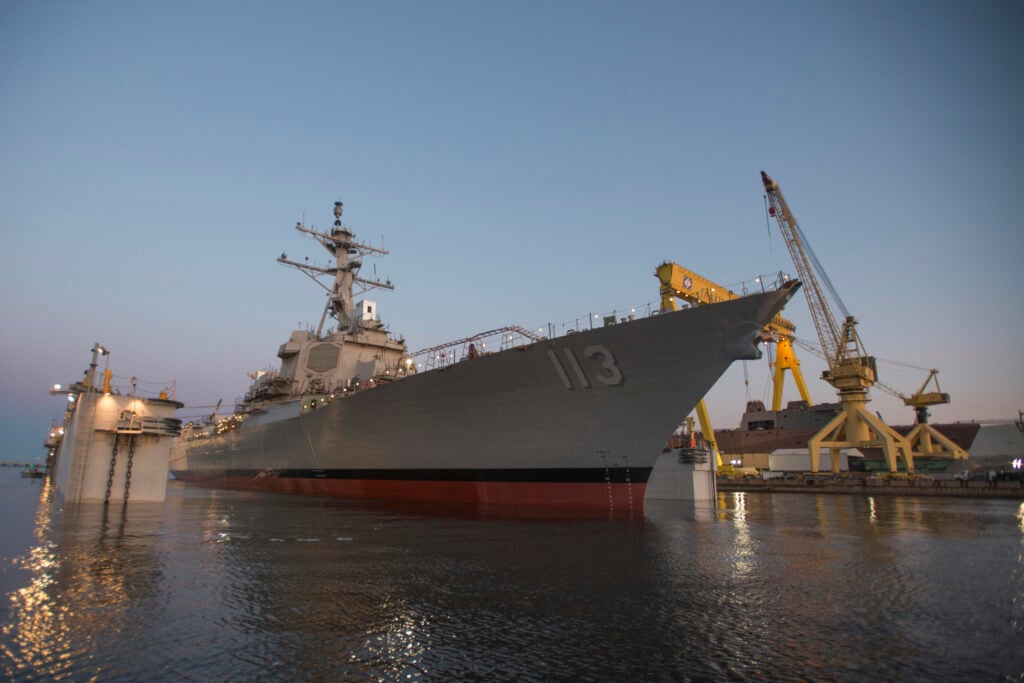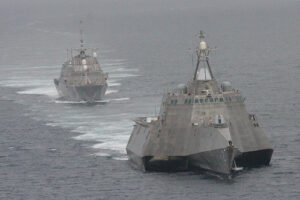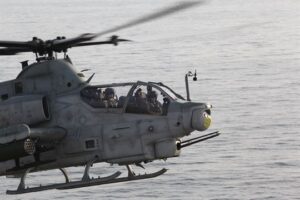No New Ships: Trump Cuts Navy Shipbuilding, Aircraft Procurement
Posted on

Launch of the destroyer USS Finn (DDG 113)
PENTAGON: Despite his campaign pledge of a 350-ship fleet, President Trump’s first budget cuts Navy shipbuilding and aircraft procurement below what was enacted in 2017, documents released today reveal. Despite Trump’s criticism of President Obama’s defense plans, this budget sticks with Obama’s shipbuilding plan for 2018: eight ships. And it actually buys eight fewer aircraft than Obama planned.
So we were overly optimistic last week when we predicted Trump would add at least one warship (a $1.8 billion Aegis destroyer) and possibly two (a $550 million Littoral Combat Ship) to the Obama plan. Instead, it adds zip, zero — nada.

Shipbuilding and aircraft procurement both fall in President Trump’s request for 2018.
Even the mix of types is exactly the same as under Obama:
- one aircraft carrier (the future CVN-80, Enterprise);
- two attack submarines (Virginia-class SSNs);
- two Aegis destroyers (Arleigh Burke-class DDGs);
- one Littoral Combat Ship or — if the new class can be started in time — a frigate;
- and two support ships (a T-ATS tug/salvage ship and a “T-Interim,” presumably what was previously called the T-AO(X) oiler).
We have heard persistent rumors that OMB director Mick Mulvaney added a second Littoral Combat Ship at the last minute after a working group warned him that buying only a single LCS would shutter one of the two shipyards involved. “There’s a discussion right now on whether or not we add some additional Littoral Combat Ships,” Mulvaney told the Hugh Hewitt Show on May 4th. “We did not add any of those as part of this $21 billion dollar request…The Navy doesn’t want them.”

LCS-2, USS Independence, followed by LCS-1, USS Freedom, showing the two different designs.
Asked point-blank today whether the Navy might yet submit a supplemental request for a second LCS, the Navy budget chief, Rear Adm. Brian Luther, shot the possibility down in the Navy budget briefing here today: “We are not submitting an amendment (to the budget) for a second LCS…. I have not been directed to create or submit a second budget submission.”
In fact, not only does the Trump budget submitted today fail to add any ships, it actually cuts the Shipbuilding & Conversion, Navy (SCN) account by more than one billion dollars, from the $21.2 billion enacted in 2017 to $19.9 billion requested for 2018.
That’s a major disappointment to Navy advocates. Admittedly, we were never going to get a 350-ship Navy overnight. The service now stands at 275 and the Congressional Budget Office says growing to 355 could take 18 years. But the Chief of Naval Operations had very publicly said shipbuilders could ramp up production in the near term. Now any progress towards 350 is delayed at least a year — perhaps more.

Navy readiness funds (O&M) jumped, while personnel, procurement, and R&D saw smaller increases.
Aircraft & Other Procurement
Aircraft procurement also drops, by more than $1.5 billion, from $16.8 billion enacted in 2017 to $15.2 billion in 2018. The number of aircraft being bought goes down as well, from 113 to 91 — in fact, it’s below the Obama plan for 2017, 99 aircraft. That said, many of this year’s planes are high-cost, high-tech, high performance fighters: 24 F-35 Joint Strike Fighters (both Marine Corps F-35Bs and Navy C-models) and 14 F/A-18E/F Super Hornets. The Navy had planned on two more F-35Cs but it decided it could cut them to save money for readiness — spare parts, ground crews, engineers — without jeopardizing the C-models’ formal Initial Operational Capability (IOC) in 2019.
The Navy also cut five MQ-8C Fire Scout surveillance drones while adding a manned scout, a P-8 Poseidon. The Marines, for their part, cut five AH-1Z Viper.Cobra gunships to buy other upgrades.

A Marine F-35B in vertical landing mode.
Naval weapons procurement, by contrast, goes up slightly, from $3.4 billion last year to $3.6 billion. That helps address troubling shortages of precision-guided munitions, which run out rapidly even in counter-terrorist strikes, let alone in a major war. Procurement of conventional ammunition also goes up, from $801 million to $1 billion. These are the kinds of procurements that contribute strongly to near-term readiness, Defense Secretary Mattis’s top priority.
Marine Corps procurement other than aircraft — ground vehicles, artillery, electronics, and the like — goes up dramatically, from $1.6 billion to $2.1 billion. That includes more than doubling spending on Joint Light Tactical Vehicles (JLTV) to replace the Humvee, from $113 to $234 million, and first 26 Amphibious Combat Vehicles (ACV) to replace geriatric amtracs. As always, it’s still a small slice of the total Navy Department budget, let alone of the Defense Department as a whole.
There’s also a significant increase in what’s blandly called “Other Procurement, Navy,” which covers all sorts of sophisticated communications and electronic warfare gear as well as mundane essentials like spare parts. That account goes from $6.6 billion in ’17 to $8.5 for ’18.

AH-1Z Viper attack helicopter, an upgraded Cobra
All told, Navy Department procurement rises slightly, by less than a billion dollars, to $49.5 billion. R&D similarly rises half a billion, to $17.7 billion. The biggest increases are plus $2 billion for military personnel, up to $47.6B, reflecting slight increases in endstrength, and a whopping $9.1 billion increase for operations and maintenance, up to $54.5 billion.
In short, like the rest of the Pentagon’s funding request, the Navy budget doesn’t reflect Trump’s campaign promises. It reflects Mattis’s decision to prioritize readiness over modernization. Ship depot maintenance is funded at 100 percent of projected need, a $1 billion increase over 2017. Aircraft depot maintenance is funded at 89 percent. Flight hours for Navy and Marine Corps aircraft are funded at “the maximum executable level” after years of shortchanging training, Rear Adm. Luther said. Aviation logistics support is funded to 87 percent of the requirement, a new high. Spare parts for aviation are funded at 91 percent of requirement, the highest level in 14 years.
“We tried to hold the line in our procurement accounts,” Rear Adm. Luther said, “(but) the direction was clear: fill the holes first.”
Subscribe to our newsletter
Promotions, new products and sales. Directly to your inbox.
